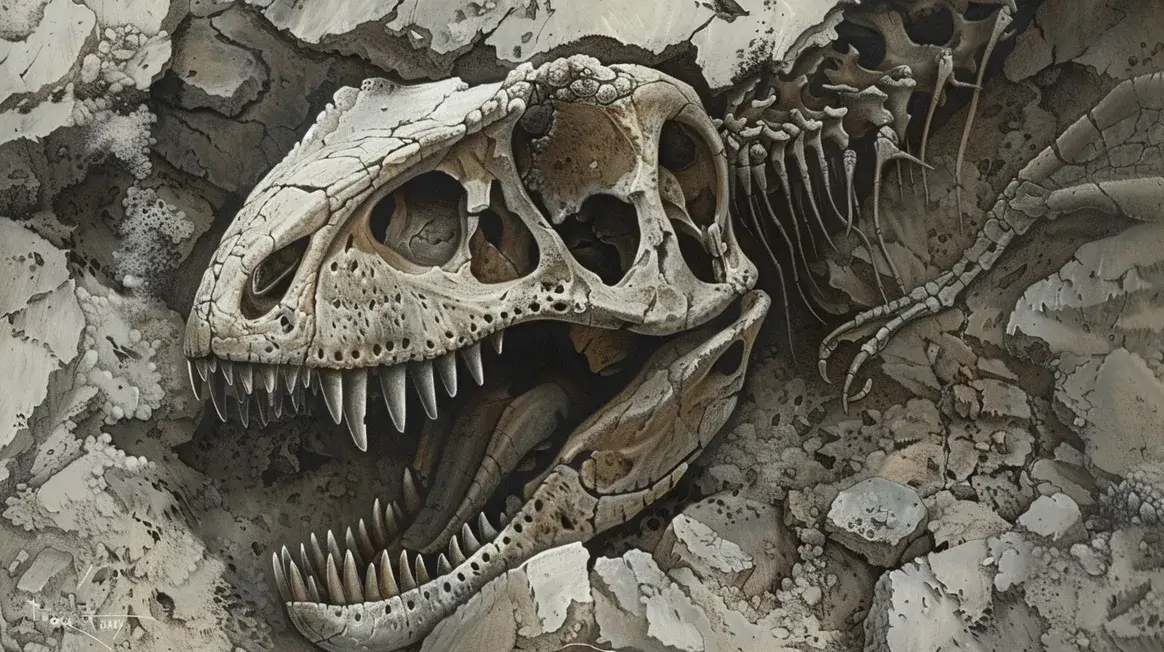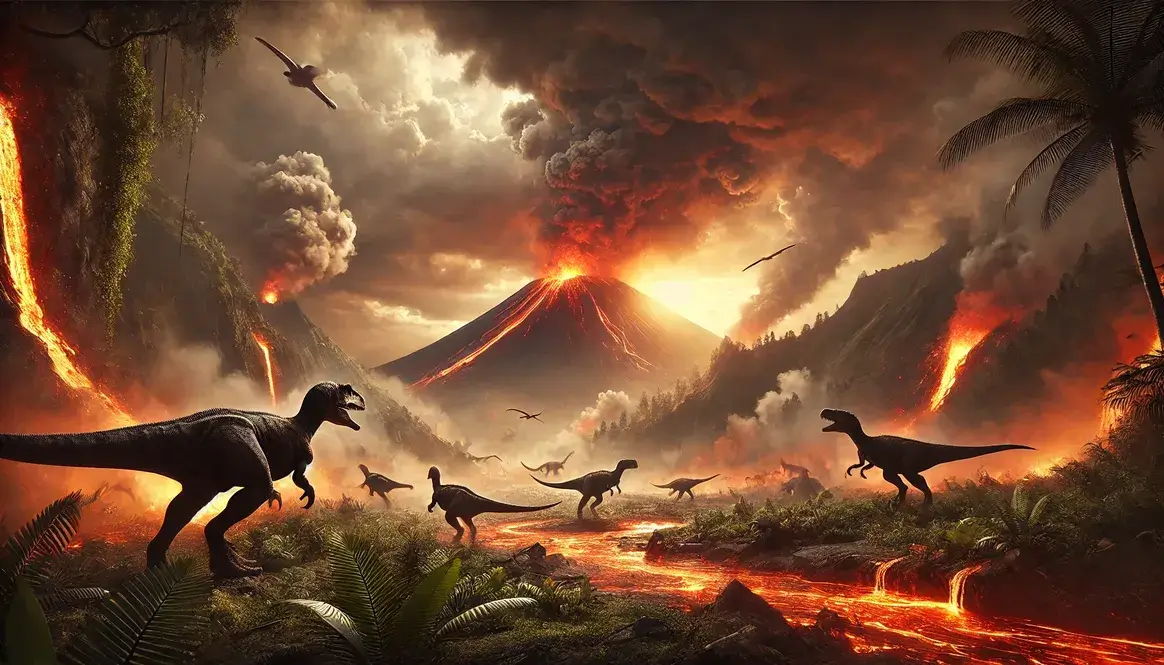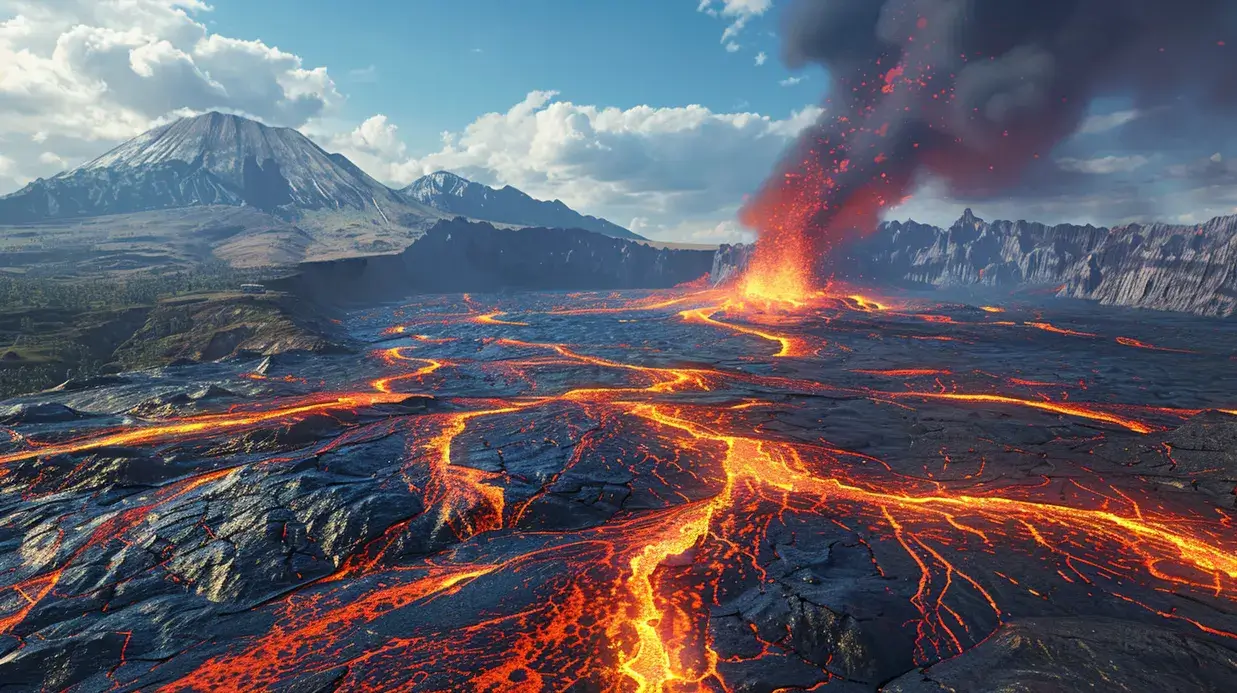Imagine uncovering a time capsule from the age of dinosaurs—one that not only preserves their remains but also captures the very air they breathed. That’s exactly what volcanic ash in dinosaur fossils offers us! These tiny particles hold secrets about ancient climates, extinction events, and the last moments of the dinosaurs. Join us as we explore the fascinating world of volcanic ash and its role in preserving prehistoric life. You’ll never look at a volcanic eruption the same way again!
| Key Takeaways | Volcanic Ash in Dinosaur Fossils |
|---|---|
| Significance | Provides crucial data on prehistoric environments and dates |
| Preservation | Rapidly buries and protects fossils, including soft tissues |
| Analysis Methods | Visual inspection, chemical tests, microscopic examination |
| Famous Examples | Pompeii-like dinosaur discoveries in ash beds |
| Research Value | Offers insights into mass extinctions and climate changes |
Understanding Volcanic Ash in Dinosaur Fossils
Volcanic ash in dinosaur fossils is like a time capsule from millions of years ago. It’s not the same as the ash you might find in a fireplace. This ash comes from volcanoes and is made up of tiny bits of rock and glass. When volcanoes erupt, they shoot these particles high into the air. The wind then carries the ash far and wide before it settles on the ground.
For paleontologists (scientists who study fossils), finding volcanic ash with dinosaur remains is incredibly valuable. It’s like discovering a prehistoric treasure chest filled with information about the world dinosaurs lived in. The ash can tell us about the climate, the landscape, and even help determine when the dinosaurs died.
Think of volcanic ash as nature’s own preservative. When it covers dinosaur remains, it acts quickly to protect them from decay. This rapid burial can lead to exceptionally well-preserved fossils, sometimes even including soft tissues that usually don’t survive the fossilization process.
But why is volcanic ash so special? Unlike other types of sediment, volcanic ash has unique properties that make it particularly useful for scientists. It often contains minerals that can be dated precisely, helping researchers pinpoint when a dinosaur lived or died. Additionally, the chemical makeup of the ash can provide clues about the environment at the time of the eruption.
Understanding volcanic ash in fossils is like learning to read a new language – a language that speaks volumes about Earth’s prehistoric past. As we delve deeper into the world of volcanic ash and dinosaur fossils, we’ll uncover the secrets hidden within these ancient time capsules.
Identifying Volcanic Ash in Dinosaur Fossils
When paleontologists unearth dinosaur remains, they’re not just looking for bones. They’re also searching for clues about the ancient world, including volcanic ash. Identifying this ash requires a combination of keen observation and scientific analysis.
Visual Clues
In fossil beds, volcanic ash often appears as distinct layers sandwiched between other rock types. These layers can vary in color, but they’re often light-colored, ranging from white to gray or even pale green. The texture of these layers is usually fine and powdery, quite different from the surrounding rock.
Paleontologists look for these telltale signs:
- Sharp boundaries between ash and other sediment layers
- Uniform thickness across wide areas
- A fine, almost flour-like texture
- Presence of small, glassy particles visible to the naked eye
Sometimes, ash layers can be quite thin, barely visible to the untrained eye. That’s why experienced fossil hunters are always on the lookout for even the slightest change in rock color or texture.
Chemical Analysis
Visual identification is just the first step. To confirm the presence of volcanic ash, scientists turn to chemical analysis. This process involves examining the elemental composition of the suspected ash layer.
One common method is X-ray fluorescence (XRF) spectroscopy. This technique bombards the sample with X-rays and measures the energy of the fluorescent X-rays emitted in response. Each element produces a unique spectral signature, allowing scientists to identify the chemical makeup of the ash.
Another powerful tool is inductively coupled plasma mass spectrometry (ICP-MS). This method can detect trace elements at very low concentrations, providing a detailed chemical fingerprint of the ash. By comparing this fingerprint to known volcanic eruptions, researchers can often pinpoint the source of the ash and its age.
Microscopic Examination
Zooming in even further, scientists use powerful microscopes to study individual ash particles. This level of detail reveals a world invisible to the naked eye.
Under the microscope, volcanic ash particles often look like tiny shards of glass. They can have various shapes:
- Y-shaped particles
- Bubble wall fragments
- Elongated needle-like crystals
These shapes are formed by the rapid cooling of molten rock as it’s ejected from a volcano. The specific shapes and textures can provide clues about the type of volcanic eruption that produced the ash.
Microscopic examination also helps distinguish volcanic ash from other fine-grained sediments. For example, wind-blown dust particles are typically more rounded, while volcanic ash particles often have sharp, jagged edges.
By combining these three approaches – visual identification, chemical analysis, and microscopic examination – paleontologists can confidently identify volcanic ash in dinosaur fossils. This ash provides crucial context for understanding the ancient environments where dinosaurs lived and offers valuable insights into the events that may have led to their extinction.
What Volcanic Ash Reveals About Prehistoric Environments
Volcanic ash in dinosaur fossils is like a secret code that scientists can decipher to learn about the world of the dinosaurs. This tiny, powdery substance holds a wealth of information about prehistoric climates, helps date fossils, and even maps out ancient volcanic activity.
Climate Information
The composition of volcanic ash can tell us a lot about the atmosphere when dinosaurs roamed the Earth. Here’s how:
- Gas Bubbles: Tiny bubbles trapped in ash particles can reveal the composition of ancient air.
- Mineral Content: Certain minerals form only under specific temperature and humidity conditions.
- Particle Size: The size of ash particles can indicate wind patterns and strength.
For example, if scientists find ash with minerals that only form in humid conditions, they can deduce that the area was once much wetter than it might be today. This information helps paint a picture of the environments where dinosaurs lived, giving us clues about their habitats and behaviors.
Sometimes, ash layers can even provide evidence of dramatic climate events. The presence of certain types of ash might indicate periods of volcanic winter, where volcanic eruptions cooled the Earth’s climate for extended periods.
Dating Fossil Discoveries
One of the most valuable aspects of volcanic ash in dinosaur fossils is its ability to act as a natural timekeeper. Ash layers often contain radioactive elements that decay at a known rate, allowing scientists to determine the age of the ash with remarkable precision.
This process, known as radiometric dating, works like this:
- Scientists identify specific radioactive elements in the ash.
- They measure the ratio of these elements to their decay products.
- Using known decay rates, they calculate how long it’s been since the ash was deposited.
Because the ash settled at the same time as the dinosaur remains, dating the ash gives us a very accurate age for the fossils. This method is so precise that it can often pinpoint the age of fossils within a few thousand years—a blink of an eye in geological time!
Mapping Ancient Volcanic Activity
Volcanic ash in dinosaur fossils doesn’t just tell us about individual sites—it helps scientists piece together a global picture of volcanic activity during the age of dinosaurs.
By studying the distribution of ash layers across different fossil sites, researchers can:
- Identify major volcanic events
- Track the spread of ash from specific eruptions
- Understand how volcanism changed over time
This information is crucial for understanding Earth’s geological history and its impact on dinosaur evolution. For instance, widespread ash deposits from the end-Cretaceous volcanoes provide evidence for the intense volcanic activity that may have contributed to the extinction of the dinosaurs.
Mapping ancient volcanic activity also helps scientists understand how volcanoes affect evolution over long periods. By comparing ash deposits with changes in fossil types, researchers can see how major eruptions might have influenced the development and extinction of different dinosaur species.
In this way, the story of volcanic ash intertwines with the story of the dinosaurs themselves, providing a fascinating glimpse into the dynamic world they inhabited.
Volcanic Ash and Fossil Preservation
Volcanic ash plays a crucial role in preserving dinosaur fossils, often leading to exceptionally well-preserved specimens. This preservation process is a combination of rapid burial and unique chemical interactions.
Rapid Burial Process
When a volcano erupts, it can blanket large areas with ash in a matter of hours or days. This rapid burial is key to fossil preservation. Here’s why:
- Protection from scavengers
- Shielding from weathering elements
- Creation of an oxygen-poor environment
Imagine a dinosaur that has just died. Normally, its remains would be exposed to the elements, eaten by scavengers, or slowly decay. But if a volcanic eruption occurs nearby, ash can quickly cover the body, protecting it from these destructive forces.
This rapid burial is similar to what happened at Pompeii, where human remains were preserved by volcanic ash. In the case of dinosaurs, this process can preserve not just bones, but sometimes even more delicate structures.
Benefits for Soft Tissue Preservation
One of the most exciting aspects of ash preservation is its ability to preserve soft tissues. These delicate structures, which normally decay quickly, can sometimes be preserved in remarkable detail when buried in volcanic ash.
Soft tissues that might be preserved include:
- Skin impressions
- Organ outlines
- Muscle fibers
- Feathers or scales
The fine particles of ash can create detailed molds of these structures before they decay. In some cases, the ash might even replace the organic material, creating a perfect replica of the original tissue.
This level of preservation gives paleontologists a rare glimpse into the anatomy of dinosaurs, providing information that can’t be obtained from bones alone.
Chemical Interactions
The preservation power of volcanic ash doesn’t stop with rapid burial. The chemical composition of the ash itself can play a significant role in fossil preservation.
Volcanic ash is often rich in minerals that can interact with organic materials in unique ways:
- Silica: This common component of volcanic ash can replace organic materials, creating detailed casts of soft tissues.
- Clay minerals: These can form a protective coating around fossils, shielding them from destructive forces.
- Iron-rich minerals: These can create a reducing environment, slowing down decay processes.
These chemical interactions can lead to different types of preservation. For example, some fossils preserved in ash show incredible 3D detail, while others might be flattened but show exquisite surface detail.
The specific chemistry of the ash can also affect the color of the resulting fossil. Some ash-preserved dinosaur fossils have distinctive hues, ranging from deep reds to pale greens, depending on the minerals present in the ash.
Understanding these chemical interactions helps paleontologists interpret the fossils they find. It allows them to distinguish between original features of the dinosaur and artifacts of the preservation process.
In some cases, the chemical environment created by volcanic ash can even preserve organic molecules. This has allowed scientists to study proteins and other biomolecules from dinosaurs, opening up new avenues for understanding dinosaur physiology and evolution.
By combining rapid burial with these unique chemical interactions, volcanic ash creates ideal conditions for fossil preservation, giving us an unparalleled window into the world of dinosaurs.
Famous Dinosaur Fossils Preserved in Volcanic Ash
Volcanic ash has given us some of the most remarkable dinosaur fossils ever discovered. These finds provide unique insights into dinosaur behavior and anatomy, often preserving details that would be lost in other fossilization processes.
Pompeii-like Dinosaur Discoveries
Just as the eruption of Mount Vesuvius preserved the residents of Pompeii in their final moments, volcanic ash has sometimes captured dinosaurs in lifelike poses. These fossils offer a rare glimpse into dinosaur behavior and their final moments.
One of the most famous examples is the “fighting dinosaurs” from Mongolia:
| Fossil Details | Description |
|---|---|
| Nickname | “Fighting Dinosaurs” |
| Species | Velociraptor and Protoceratops |
| Preservation | Found locked in combat, likely buried by a sudden sandstorm or collapsing sand dune |
| Significance | Provides evidence of predator-prey relationships and dinosaur behavior |
While not preserved in volcanic ash, this example illustrates how rapid burial can preserve dinosaurs in life-like poses. Similar preservation has been found in ash deposits.
Another fascinating discovery comes from China:
| Fossil Details | Description |
|---|---|
| Nickname | “Sleeping Dragon” |
| Species | Mei long (small troodontid dinosaur) |
| Age | About 130 million years old |
| Pose | Curled up in a sleeping position |
| Preservation | Buried in volcanic ash |
| Significance | Suggests bird-like sleeping behavior in some dinosaurs |
These “Pompeii-like” discoveries provide valuable insights into dinosaur behavior and physiology, frozen in time by volcanic ash.
Well-Preserved Fossils from Ash Beds
Volcanic ash beds have yielded some of the best-preserved dinosaur fossils ever found. These fossils often retain detailed skin impressions, feathers, and even soft tissue structures.
One spectacular example comes from the Jehol Biota in China:
- Fossil: Sinosauropteryx
- Preservation: Extremely well-preserved feathers and skin pigments
- Significance: First non-avian dinosaur found with evidence of feathers
- Discovery Date: 1996
The fine-grained volcanic ash preserved not only the skeleton but also the outline of feathers and even enabled scientists to determine the dinosaur’s coloration. This find revolutionized our understanding of feathered dinosaurs and their relationship to modern birds.
Another remarkable ash-preserved fossil is:
| Fossil Details | Description |
|---|---|
| Nickname | “Leonardo” |
| Species | Brachylophosaurus (duck-billed dinosaur) |
| Location | Montana, USA |
| Preservation | Buried in volcanic ash |
| Significance | Suggests bird-like sleeping behavior in some dinosaurs |
Leonardo’s remains were buried in volcanic ash, which preserved soft tissues, skin texture, and even the contents of its stomach. This level of preservation is extremely rare and provides unprecedented insights into the anatomy of dinosaurs and their diets.
These examples showcase the extraordinary preservation potential of volcanic ash. By rapidly burying and chemically preserving dinosaur remains, ash deposits have provided us with some of our most detailed and lifelike glimpses into the world of these ancient creatures. Each new discovery in ash beds has the potential to revolutionize our understanding of dinosaur biology and behavior.
Volcanic Ash and Mass Extinctions
Volcanic ash plays a significant role in our understanding of mass extinctions throughout Earth’s history. It provides crucial evidence for the environmental changes that led to these catastrophic events, including the famous extinction that marked the end of the dinosaur era.
The K-Pg Extinction Event
The Cretaceous-Paleogene (K-Pg) extinction event, which wiped out the non-avian dinosaurs about 66 million years ago, is perhaps the most well-known mass extinction. Volcanic ash has been a key player in the ongoing debate about what caused this extinction.
While an asteroid impact is widely accepted as the primary cause, volcanic activity also played a significant role. The Deccan Traps, a massive volcanic province in India, were erupting around the time of the extinction. These eruptions produced enormous amounts of ash and gases, which had far-reaching effects on the global climate.
Volcanic ash from the Deccan Traps provides evidence for:
- Prolonged environmental stress before the asteroid impact
- Release of large amounts of greenhouse gases
- Potential ocean acidification
The presence of this ash in K-Pg boundary layers around the world helps scientists piece together the complex series of events that led to the dinosaurs’ demise.
Other Extinction Events
Volcanic ash has been linked to several other mass extinctions throughout Earth’s history. Here are a couple of notable examples:
End-Permian Extinction (The Great Dying)
- When: About 252 million years ago
- Extinction Rate: Up to 96% of marine species and 70% of terrestrial vertebrate species
- Volcanic Evidence: Siberian Traps eruptions
The End-Permian extinction, the largest known extinction event, coincided with massive volcanic eruptions in Siberia. Ash layers from these eruptions are found worldwide and provide crucial dating evidence. The ash and associated gases likely caused severe climate change, leading to widespread ecosystem collapse.
End-Triassic Extinction
This extinction event, which occurred about 201 million years ago, paved the way for dinosaurs to dominate the Earth. Volcanic ash plays a key role in our understanding of this event:
| Aspect | Details |
|---|---|
| Timing | Coincides with Central Atlantic Magmatic Province (CAMP) volcanism |
| Ash Evidence | Found in sedimentary rocks across multiple continents |
| Environmental Effects | Rapid warming, ocean acidification |
| Impact on Life | Up to 80% of species became extinct |
The ash layers from CAMP volcanism provide crucial evidence for the timing and extent of these eruptions, helping scientists link them to the mass extinction.
In both these cases, as with the K-Pg extinction, volcanic ash serves as a valuable tool for understanding the mechanisms behind mass extinctions. It provides datable layers that help establish timelines, and its composition offers clues about the environmental changes that drove these catastrophic events.
By studying volcanic ash associated with these extinctions, scientists can better understand how volcanoes affect evolution on a grand scale. This knowledge not only helps us piece together Earth’s past but also provides insights into how modern volcanic activity might impact our planet’s future.
Studying Volcanic Ash: Tools and Techniques
The study of volcanic ash in dinosaur fossils requires a combination of field work and laboratory analysis. Paleontologists and geologists use a variety of tools and techniques to gather, process, and analyze ash samples, uncovering the secrets held within these ancient deposits.
Field Collection Methods
Collecting volcanic ash samples in the field is a delicate process that requires careful planning and execution. Paleontologists follow these general steps:
- Site identification: Using geological maps and previous research, scientists locate potential ash layers in fossil-bearing rocks.
- Careful excavation: Researchers use small tools like trowels, brushes, and dental picks to expose the ash layer without contaminating it.
- Sample collection: Clean, uncontaminated samples are collected using sterile tools and stored in labeled containers.
- Detailed documentation: The exact location, stratigraphic position, and surrounding rock types are meticulously recorded.
- Photography: High-resolution photos are taken to document the ash layer in situ.
One crucial tool in field collection is the GPS unit, which allows precise recording of sample locations. This information is vital for creating accurate maps of ancient volcanic activity and understanding the distribution of ash falls.
Paleontologists also use specialized equipment like portable X-ray fluorescence (XRF) analyzers. These handheld devices can provide immediate elemental analysis of ash samples in the field, helping researchers quickly identify promising deposits.
Laboratory Analysis
Once volcanic ash samples reach the laboratory, they undergo a series of sophisticated analyses to reveal their secrets. Here’s an overview of some key techniques:
Microscopic Examination Scientists use powerful microscopes to study the shape, size, and composition of individual ash particles. This can reveal:
- The type of volcanic eruption that produced the ash
- The distance the ash traveled from its source
- Any alterations the ash has undergone since deposition
Chemical Analysis Several methods are used to determine the chemical composition of ash samples:
| Technique | What It Measures | Why It’s Important |
|---|---|---|
| X-ray Fluorescence (XRF) | Elemental composition | Identifies source volcano, helps with dating |
| Inductively Coupled Plasma Mass Spectrometry (ICP-MS) | Trace elements | Provides detailed “fingerprint” of ash |
| Electron Microprobe | Chemical composition of individual particles | Reveals variations within a single ash layer |
These chemical analyses are crucial for correlating ash layers across different sites and for precise dating of the deposits.
Radiometric Dating For ash layers containing suitable minerals, radiometric dating techniques can provide precise ages. Common methods include:
- Potassium-Argon (K-Ar) dating
- Argon-Argon (Ar-Ar) dating
- Uranium-Lead (U-Pb) dating of zircon crystals
These dating methods are essential for establishing the chronology of dinosaur extinction events and understanding the timing of major volcanic episodes.
Isotope Analysis Studying the ratios of different isotopes in ash can provide information about:
- Ancient atmospheric conditions
- Temperature at the time of eruption
- Environmental changes associated with volcanic activity
By combining these various analytical techniques, scientists can extract a wealth of information from volcanic ash found in dinosaur fossils. This multidisciplinary approach allows researchers to reconstruct ancient environments, date crucial events in Earth’s history, and better understand the world in which dinosaurs lived and ultimately went extinct.
Conclusion
Volcanic ash in dinosaur fossils is truly a window into the prehistoric world. From preserving delicate structures to providing crucial dating information, it continues to shape our understanding of dinosaurs and their environment. As technology advances, who knows what new secrets these ancient ash deposits might reveal? The next time you hear about a dinosaur discovery, remember that it might be volcanic ash that helped bring that ancient creature back to life in our imaginations.









